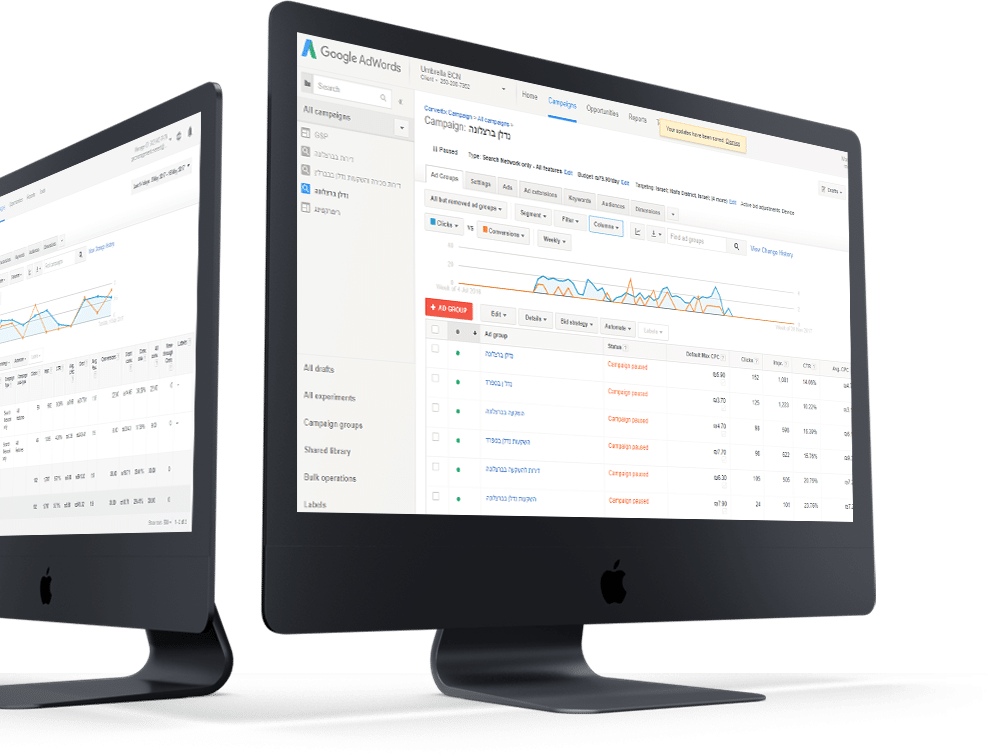Google Advertising. Where it all "clicks"
Turn search results into revenue

Search
Banner Promotion (GDN)
Google Display Network, Google’s network of publishers, allows you to display banner ads on millions of websites. This exposure reaches an unrivaled number of potential customers worldwide.
Combine beautifully designed banners or text ads on sites that utilize Google’s advertising tools (most sites do).


Gmail Advertising
Imagine being able to step into your customers’ Gmail box and place advertisements on it. Actually, this has been possible for quite some time.
In fact, Google has been integrating ads into the Gmail boxes of users since 2014. But, not to worry – ads distinctly appear under the “Promotion” tab, so that users can clearly distinguish between ads and other content.
Some options available to advertisers involve designing the e-mail as a landing page and using familiar features of Gmail, such as transfer to friends, save, and more.
Remarketing
No potential customer should ever be forfeited. Marketing studies show that repeated exposure significantly increases chances of interested customers eventually buying. Hence, the remarketing method.
Google can “tag” customers who have visited your site and show them advertisements for it while they browse other sites, including YouTube. Clever, right? Just wait until you see how effective it is.




Traffic-producing areas:
Promo code
$100
Google Campaign
Join us, and get $100 off of your first campaign
How do I advertise on Google?
Adwords, Google’s most popular advertising tool, is based around search terms or phrases. An effective Adwords campaign starts by researching keywords relevant to the product or service and estimating the competition for those phrases from other advertisers.
The next steps involve setting ad type, writing text, selecting target audiences, budget, and advertising channels, and ultimately, launching the campaign into the virtual space. Once the campaign is launched, Google’s tools and statistics can measure its effectiveness, make corrections, and maximize efficiency.
Where will the ads appear?
Google offers two main options for displaying ads: Search engines and Google Display Network. Each option has advantages for different purposes.
Ads that appear on search engines are meant for surfers actively searching for you/the products or services you offer. That is, customers typed in an expression that is organically promoted within your content. Customers can find you, even if they did not search for you specifically.
This can be particularly effective for remarketing. It keeps your marketing messages in the minds of customers, even after they have left your site or searched for a term related to your business.
What is a remarketing campaign?
Remarketing is a smart method that enables businesses to track potential customers who visited their site as they browse other sites.
How does it work? Users who enter your site, click on your ad, or search for key phrases connected to you are tagged and later exposed to your ads in a variety of channels, like YouTube and the Google Partner Network.
An effective remarketing campaign requires in-depth knowledge of not only the technological tools available, but also of your different target audiences, marketing strategy, and the nature of your business. We recommend that you do not attempt a remarketing campaign without the professional help that you can get from companies like ours.
Can you segment the target audience on Google?
Definitely! Google can segment target audiences according to several parameters: location, language, device types, and more. Each campaign can be set by budget, start and end dates, and many more precise settings that only reach specific audience.
But, you can’t stop there. Once the campaign is launched, you must test its effectiveness, refine your target audience settings and their types of referrals, as well as your budget. If this all feels a bit big for you, talk to us and we will be happy to do it for you.
What is CPC?
Cost Per Click is one of the accepted payment methods for Google campaigns, along with other companies that offer online advertising.
CPC advertisers pay a flat rate each time a user clicks on their ad. Though it seems simple, there are quite a few drawbacks that accompany the advantages of this model. So before you make any decisions, let’s meet and figure out whether this is the best model for you.
What is CPA?
What is CPM?
Cost Per Thousand, or payment for every 1,000 exposures. Recommended for advertisers looking to reach a relatively large audience at low costs.
Advertisers pay for every 1,000 ad exposures, whether they have been to the same surfers multiple times, or to 1,000 different surfers. Is this model right for you? Call us and we’ll check it out together.
What is CPI?
CPI, or Cost Per Install, only requires payment for actual installation. It was created to accompany the new Google Play and Apple App Store platforms.
CPI helps app creators in various fields by promoting them in the app store but only requiring them to pay for installation onto the consumers’ device(s).
Want to promote your app with full control over your promotion budget? We’re happy to show you the benefits of CPI and offer even more options for promoting your app.